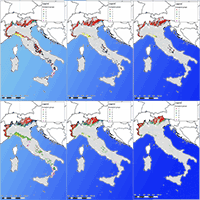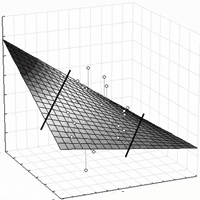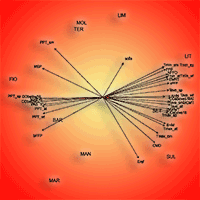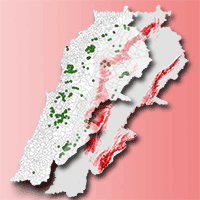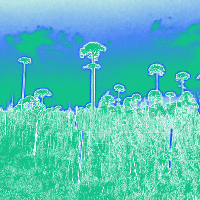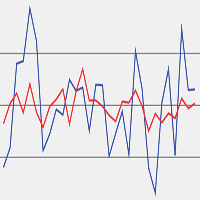Spatial modelling is a fundamental tool to support forest management strategies. National Forest Inventories (NFIs) provide extensive and detailed data for spatial analysis. In this study, the most recent Italian NFI (INFC2005) was used to evaluate possible refinements on species distribution model (SDM) techniques and to derive the future scenarios for two target species (Fagus sylvatica L. and Abies alba Mill.) sharing a similar ecological environment and geographic range. A weighted SDM and a provenance distribution model (PDM) were tested, based on tree-level selection of NFI plots using species basal area as a filter. Two climate projections were analysed for 2050s according to the IPCC 5th Assessment Report (AR5). The results were evaluated as possible guidelines for management of the Italian region of the EUFGIS network, where many marginal forest populations (MaPs) are currently included as genetic conservation units (GCUs). The uncertainty of coordinates of inventory points did not affect the results of SDM. No statistical differences were found when comparing the niche realization for the two model species (ANOVA p>0.05) mainly due to spatial autocorrelation between the environmental predictors. Based on the classic SDM evaluation method (True Skill Statistic - TSS) little improvements in predictions were observed when weighting each presence/absence records, possibly due to the lack of adequate ancillary data but also to the evaluation method. A higher accuracy of predictions (TSS>0.85) was obtained when different “provenances” were modelled separately, due to the reduction in the “background noise”. We showed that for classical SDM, the prevalence of certain ecological features of some locations may drive algorithms to produce coarse averaged predictions. Provenance distribution modelling may represent a valuable step forward in spatial analysis, particularly for the detection of marginal peripheral populations. The exact spatial co-ordinates of plots and additional information on site quality (e.g., stand age, site index, etc.) in NFI data could greatly help in better weighting presence/absence data and properly test the new evaluation methods.
Keywords
, , , , , ,
Citation
Marchi M, Ducci F (2018). Some refinements on species distribution models using tree-level National Forest Inventories for supporting forest management and marginal forest population detection. iForest 11: 291-299. - doi: 10.3832/ifor2441-011
Academic Editor
Piermaria Corona
Paper history
Received: Mar 23, 2017
Accepted: Feb 06, 2018
First online: Apr 13, 2018
Publication Date: Apr 30, 2018
Publication Time: 2.20 months
© SISEF - The Italian Society of Silviculture and Forest Ecology 2018
Open Access
This article is distributed under the terms of the Creative Commons Attribution-Non Commercial 4.0 International (https://creativecommons.org/licenses/by-nc/4.0/), which permits unrestricted use, distribution, and reproduction in any medium, provided you give appropriate credit to the original author(s) and the source, provide a link to the Creative Commons license, and indicate if changes were made.

Breakdown by View Type
(Waiting for server response...)
Article Usage
Total Article Views: 50869
(from publication date up to now)
Breakdown by View Type
HTML Page Views: 41532
Abstract Page Views: 3769
PDF Downloads: 4302
Citation/Reference Downloads: 49
XML Downloads: 1217
Web Metrics
Days since publication: 2819
Overall contacts: 50869
Avg. contacts per week: 126.32
Article Citations
Article citations are based on data periodically collected from the Clarivate Web of Science web site
(last update: Mar 2025)
Total number of cites (since 2018): 26
Average cites per year: 3.25
Publication Metrics
by Dimensions ©
Articles citing this article
List of the papers citing this article based on CrossRef Cited-by.
(1)
Allouche O, Tsoar A, Kadmon R (2006)Assessing the accuracy of species distribution models: prevalence, kappa and the true skill statistic (TSS). Journal of Applied Ecology 43: 1223-1232.
CrossRef |
Gscholar
(2)
Araújo MB, New M (2007)Ensemble forecasting of species distributions. Trends in Ecology and Evolution 22: 42-7.
CrossRef |
Gscholar
(3)
Barbet-Massin M, Jiguet F, Albert CH, Thuiller W (2012)Selecting pseudo-absences for species distribution models: how, where and how many? Methods in Ecology and Evolution 3: 327-338.
CrossRef |
Gscholar
(4)
Bedia J, Herrera S, Gutiérrez JM (2013)Dangers of using global bioclimatic datasets for ecological niche modeling. Limitations for future climate projections. Global and Planetary Change 107: 1-12.
CrossRef |
Gscholar
(5)
Borghetti M, Chirici G (2016)Raw data from the Italian National Forest Inventory are on-line and publicly available. Forest@ - Journal of Silviculture and Forest Ecology 13 (1): 33-34. [in Italian with English summary]
CrossRef |
Gscholar
(6)
Brus DJ, Hengeveld GM, Walvoort DJJ, Goedhart PW, Heidema AH, Nabuurs GJ, Gunia K (2012)Statistical mapping of tree species over Europe. European Journal of Forest Research 131: 145-157.
CrossRef |
Gscholar
(7)
Castaldi C, Vacchiano G, Marchi M, Corona P (2017)Projecting nonnative Douglas fir plantations in Southern Europe with the forest vegetation simulator. Forest Science 63: 101-110.
CrossRef |
Gscholar
(8)
Costantini E, Barbetti R, Fantappiè M, L’Abate G, Lorenzetti R, Napoli R, Marchetti A, Rivieccio R (2014)The soil map of Italy: a hierarchy of geodatabases, from soil regions to sub-systems. In: “GlobalSoilMap Basis of the global spatial soil information system” (Arrouays D, McKenzie N, Hempel J, Richer de Forges A, McBratney AB eds). CRC Press Taylor & Francis Group, London, UK, pp. 109-112.
Gscholar
(9)
Eckert CG, Samis KE, Lougheed SC (2008)Genetic variation across species’ geographical ranges: the central-marginal hypothesis and beyond. Molecular Ecology 17: 1170-1188.
CrossRef |
Gscholar
(10)
Fady B, Aravanopoulos FA, Alizoti P, Mátyás C, Wühlisch G, Westergren M, Belletti P, Cvjetkovic B, Ducci F, Huber G, Kelleher CT, Khaldi A, Kharrat MBD, Kraigher H, Kramer K, Mühlethaler U, Peric S, Perry A, Rousi M, Sbay H, Stojnic S, Tijardovic M, Tsvetkov I, Varela MC, Vendramin GG, Zlatanov T (2016)Evolution-based approach needed for the conservation and silviculture of peripheral forest tree populations. Forest Ecology and Management 375: 66-75.
CrossRef |
Gscholar
(11)
Fattorini L (2015)Design-based methodological advances to support national forest inventories: a review of recent proposals. iForest - Biogeosciences and Forestry 8 (1): 6-11.
CrossRef |
Gscholar
(12)
Friedman M (1937)The use of ranks to avoid the assumption of normality implicit in the analysis of variance. Journal of the American Statistical Association 32: 675-701.
CrossRef |
Gscholar
(13)
Fick SE, Hijmans RJ (2017)WorldClim 2: new 1-km spatial resolution climate surfaces for global land areas. International Journal of Climatology 37: 4302-4315.
CrossRef |
Gscholar
(14)
Fridman J, Holm S, Nilsson M, Nilsson P, Ringvall AH, Ståhl G (2014)Adapting National Forest Inventories to changing requirements - the case of the Swedish National Forest Inventory at the turn of the 20th century. Silva Fennica 48 (3): art-1095, pp. 29.
CrossRef |
Gscholar
(15)
Hamann A, Roberts DR, Barber QE, Carroll C, Nielsen SE (2015)Velocity of climate change algorithms for guiding conservation and management. Global Change Biology 21: 997-1004.
CrossRef |
Gscholar
(16)
Isaac-Renton MG, Roberts DR, Hamann A, Spiecker H (2014)Douglas-fir plantations in Europe: a retrospective test of assisted migration to address climate change. Global Change Biology 20: 2607-2617.
CrossRef |
Gscholar
(17)
Ivetić V, Devetaković J, Nonić M, Stanković D, Šijačić-Nikolić M (2016)Genetic diversity and forest reproductive material - from seed source selection to planting. iForest - Biogeosciences and Forestry 9 (5): 801-812.
CrossRef |
Gscholar
(18)
Kerr G, Stokes V, Peace A, Jinks R (2015)Effects of provenance on the survival, growth and stem form of European silver fir (
Abies alba Mill.) in Britain. European Journal of Forest Research 134: 349-363.
CrossRef |
Gscholar
(19)
Kingsolver JG, Diamond SE (2011)Phenotypic selection in natural populations: what limits directional selection? The American naturalist 177: 346-57.
CrossRef |
Gscholar
(20)
Kramer K, Ducousso A, Gömöry D, Hansen JK, Ionita L, Liesebach M, LorenÅ A, Schüler S, Sulkowska M, De Vries S, Von Wühlisch G (2017)Chilling and forcing requirements for foliage bud burst of European beech (
Fagus sylvatica L.) differ between provenances and are phenotypically plastic. Agricultural and Forest Meteorology 234: 172-181.
CrossRef |
Gscholar
(21)
Kruskal W, Wallis W (1952)Use of ranks in one-criterion variance analysis. Journal of the American Statistical Association 47: 583-621.
CrossRef |
Gscholar
(22)
Lira-Noriega A, Manthey JD (2014)Relationship of genetic diversity and niche centrality: a survey and analysis. Evolution 68: 1082-1093.
CrossRef |
Gscholar
(23)
Manel S, Williams HC, Ormerod SJ (2001)Evaluating presence absence models in ecology; the need to count for prevalence. Journal of Applied Ecology 38: 921-931.
CrossRef |
Gscholar
(24)
Marchi M, Castaldi C, Merlini P, Nocentini S, Ducci F (2015)Stand structure and influence of climate on growth trends of a marginal forest population of
Pinus nigra spp.
nigra. Annals of Silvicultural Research 39: 100-110.
CrossRef |
Gscholar
(25)
Marchi M, Nocentini S, Ducci F (2016)Future scenarios and conservation strategies for a rear-edge marginal population of
Pinus nigra Arnold in Italian central Apennines. Forest Systems 25: e072.
CrossRef |
Gscholar
(26)
Marchi M, Chiavetta U, Castaldi C, Ducci F (2017)Does complex always mean powerful? A comparison of eight methods for interpolation of climatic data in Mediterranean area. Italian Journal of Agrometeorology 1: 59-72.
CrossRef |
Gscholar
(27)
McRoberts R, Tomppo E, Schadauer K, Vidal C, Ståhl G, Chirici G, Lanz A, Cienciala E, Winter S, Smith B (2009)Harmonizing national forest inventories. Journal of Forestry 58: 179-187.
Online |
Gscholar
(28)
Merow C, Smith MJ, Edwards TC, Guisan A, McMahon SM, Normand S, Thuiller W, Wüest RO, Zimmermann NE, Elith J (2014)What do we gain from simplicity
versus complexity in species distribution models? Ecography 37: 1267-1281.
CrossRef |
Gscholar
(29)
Merow C, Smith MJ, Silander JA (2013)A practical guide to MaxEnt for modeling species’ distributions: what it does, and why inputs and settings matter. Ecography 36: 1058-1069.
CrossRef |
Gscholar
(30)
Molyneux N, Soares I, Neto F (2014)Modeling current and future climates using WorldClim and DIVA software: case studies from Timor Leste and India. Journal of Crop Improvement 28: 619-640.
CrossRef |
Gscholar
(31)
Myers N, Mittermeier R, Fonseca G, Kent J (2000)Biodiversity hotspots for conservation priorities. Nature 403: 853-858.
CrossRef |
Gscholar
(32)
Naimi B, Skidmore AK, Groen TA, Hamm NAS (2011)Spatial autocorrelation in predictors reduces the impact of positional uncertainty in occurrence data on species distribution modelling. Journal of Biogeography 38: 1497-1509.
CrossRef |
Gscholar
(33)
Noce S, Collalti A, Valentini R, Santini M (2016)Hot spot maps of forest presence in the Mediterranean basin. iForest - Biogeosciences and Forestry 9 (5): 766-774.
CrossRef |
Gscholar
(34)
O’Brien EK, Mazanec RA, Krauss SL (2007)Provenance variation of ecologically important traits of forest trees: implications for restoration. Journal of Applied Ecology 44: 583-593.
CrossRef |
Gscholar
(35)
Orlovic S, Ivankovic M, Andonoski V, Stojnic S, Isajev V (2014)Forest genetic resources to support global bioeconomy. Annals of Silvicultural Research 38: 51-61.
CrossRef |
Gscholar
(36)
Petit RJ, Aguinagalde I, De Beaulieu J-L, Bittkau C, Brewer S, Cheddadi R, Ennos R, Fineschi S, Grivet D, Lascoux M, Mohanty A, Müller-Starck G, Demesure-Musch B, Palmé A, Martín JP, Rendell S, Vendramin GG (2003)Glacial refugia: hotspots but not melting pots of genetic diversity. Science 300: 1563-1565.
CrossRef |
Gscholar
(37)
Petr M, Boerboom L, Ray D, Van Der Veen A (2014)An uncertainty assessment framework for forest planning adaptation to climate change. Forest Policy and Economics 41: 1-11.
CrossRef |
Gscholar
(38)
Piotti A, Leonarduzzi C, Postolache D, Bagnoli F, Spanu I, Brousseau L, Urbinati C, Leonardi S, Vendramin GG (2017)Unexpected scenarios from Mediterranean refugial areas: disentangling complex demographic dynamics along the Apennine distribution of silver fir. Journal of Biogeography 44 (7): 1547-1558.
CrossRef |
Gscholar
(39)
R Core Team (2017)R: a language and environment for statistical computing. R Foundation, Vienna, Austria.
Online |
Gscholar
(40)
Ray D, Petr M, Mullett M, Bathgate S, Marchi M, Beauchamp K (2017)A simulation-based approach to assess forest policy options under biotic and abiotic climate change impacts: A case study on Scotland’s National Forest Estate. Forest Policy and Economics 89: 1-11.
CrossRef |
Gscholar
(41)
Rehfeldt GE, Worrall JJ, Marchetti SB, Crookston NL (2014)Adapting forest management to climate change using bioclimate models with topographic drivers. Forestry 88: 528-539.
CrossRef |
Gscholar
(42)
Rose L, Leuschner C, Köckemann B, Buschmann H (2009)Are marginal beech (
Fagus sylvatica L.) provenances a source for drought tolerant ecotypes? European Journal of Forest Research 128: 335-343.
CrossRef |
Gscholar
(43)
San-Miguel-Ayanz J, De Rigo D, Caudullo G, Houston Durrant T, Mauri A (2016)European atlas of forest tree species. Publication Office of the European Union, Luxembourg.
CrossRef |
Gscholar
(44)
Schueler S, Kapeller S, Konrad H, Geburek T, Mengl M, Bozzano M, Koskela J, Lefèvre F, Hubert J, Kraigher H, Longauer R, Olrik DC (2013)Adaptive genetic diversity of trees for forest conservation in a future climate: A case study on Norway spruce in Austria. Biodiversity and Conservation 22: 1151-1166.
CrossRef |
Gscholar
(45)
Swets JA (1988)Measuring the accuracy of diagnostic systems. Science 240: 1285-1293.
CrossRef |
Gscholar
(46)
Thuiller W, Pollock LJ, Gueguen M, Münkemüller T (2015)From species distributions to meta-communities. Ecology Letters 18 (12): 1321-1328.
CrossRef |
Gscholar
(47)
Thuiller W, Georges D, Engler R (2016)biomod2: ensemble platform for species distribution modeling. R package version 3:3-7.
Online |
Gscholar
(48)
Tinner W, Colombaroli D, Heiri O, Henne PD, Steinacher M, Untenecker J, Vescovi E, Allen JRM, Carraro G, Conedera M, Joos F, Lotter AF, Luterbacher J, Samartin S, Valsecchi V (2013)The past ecology of
Abies alba provides new perspectives on future responses of silver fir forests to global warming. Ecological Monographs 83: 419-439.
CrossRef |
Gscholar
(49)
Vacchiano G, Motta R (2015)An improved species distribution model for Scots pine and downy oak under future climate change in the NW Italian Alps. Annals of Forest Science 72: 321-334.
CrossRef |
Gscholar
(50)
Williams MI, Dumroese RK (2013)Preparing for climate change: forestry and assisted migration. Journal of Forestry 111: 287-297.
CrossRef |
Gscholar
